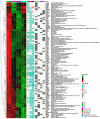Long-Term In Vitro Culture Alters Gene Expression Pattern of Genes Involved in Ontological Groups Representing Cellular Processes
- PMID: 39000215
- PMCID: PMC11241590
- DOI: 10.3390/ijms25137109
Long-Term In Vitro Culture Alters Gene Expression Pattern of Genes Involved in Ontological Groups Representing Cellular Processes
Abstract
The oviduct provides an optimal environment for the final preparation, transport, and survival of gametes, the fertilization process, and early embryonic development. Most of the studies on reproduction are based on in vitro cell culture models because of the cell's accessibility. It creates opportunities to explore the complexity of directly linked processes between cells. Previous studies showed a significant expression of genes responsible for cell differentiation, maturation, and development during long-term porcine oviduct epithelial cells (POECs) in vitro culture. This study aimed at establishing the transcriptomic profile and comprehensive characteristics of porcine oviduct epithelial cell in vitro cultures, to compare changes in gene expression over time and deliver information about the expression pattern of genes highlighted in specific GO groups. The oviduct cells were collected after 7, 15, and 30 days of in vitro cultivation. The transcriptomic profile of gene expression was compared to the control group (cells collected after the first day). The expression of COL1A2 and LOX was enhanced, while FGFBP1, SERPINB2, and OVGP1 were downregulated at all selected intervals of cell culture in comparison to the 24-h control (p-value < 0.05). Adding new detailed information to the reproductive biology field about the diversified transcriptome profile in POECs may create new future possibilities in infertility treatments, including assisted reproductive technique (ART) programmes, and may be a valuable tool to investigate the potential role of oviduct cells in post-ovulation events.
Keywords: RNA processing; cell adhesion; cell migration; intercellular communication; reproductive biology.
Conflict of interest statement
The authors declare no conflicts of interests.
Figures






Similar articles
-
New Gene Markers Expressed in Porcine Oviductal Epithelial Cells Cultured Primary In Vitro Are Involved in Ontological Groups Representing Physiological Processes of Porcine Oocytes.Int J Mol Sci. 2021 Feb 19;22(4):2082. doi: 10.3390/ijms22042082. Int J Mol Sci. 2021. PMID: 33669854 Free PMC article.
-
"Biological Adhesion" is a Significantly Regulated Molecular Process during Long-Term Primary In Vitro Culture of Oviductal Epithelial Cells (Oecs): A Transcriptomic and Proteomic Study.Int J Mol Sci. 2019 Jul 10;20(14):3387. doi: 10.3390/ijms20143387. Int J Mol Sci. 2019. PMID: 31295879 Free PMC article.
-
Oxygen levels affect oviduct epithelium functions in air-liquid interface culture.Histochem Cell Biol. 2024 Jun;161(6):521-537. doi: 10.1007/s00418-024-02273-1. Epub 2024 Mar 26. Histochem Cell Biol. 2024. PMID: 38530407 Free PMC article.
-
A Comparative View on the Oviductal Environment during the Periconception Period.Biomolecules. 2020 Dec 17;10(12):1690. doi: 10.3390/biom10121690. Biomolecules. 2020. PMID: 33348856 Free PMC article. Review.
-
The role of oviduct-specific glycoprotein (OVGP1) in modulating biological functions of gametes and embryos.Histochem Cell Biol. 2022 Mar;157(3):371-388. doi: 10.1007/s00418-021-02065-x. Epub 2022 Jan 6. Histochem Cell Biol. 2022. PMID: 34993641 Free PMC article. Review.
References
-
- Avilés M., Coy P., Rizos D. The oviduct: A key organ for the success of early reproductive events. Anim. Front. 2015;5:25–31. doi: 10.2527/af.2015-0005. - DOI
-
- Rybska M., Knap S., Jankowski M., Jeseta M., Bukowska D., Antosik P., Nowicki M., Zabel M., Kempisty B., Jaśkowski J.M. Characteristic of factors influencing the proper course of folliculogenesis in mammals. Med. J. Cell Biol. 2018;6:33–38. doi: 10.2478/acb-2018-0006. - DOI
MeSH terms
Grants and funding
LinkOut - more resources
Full Text Sources
Miscellaneous

